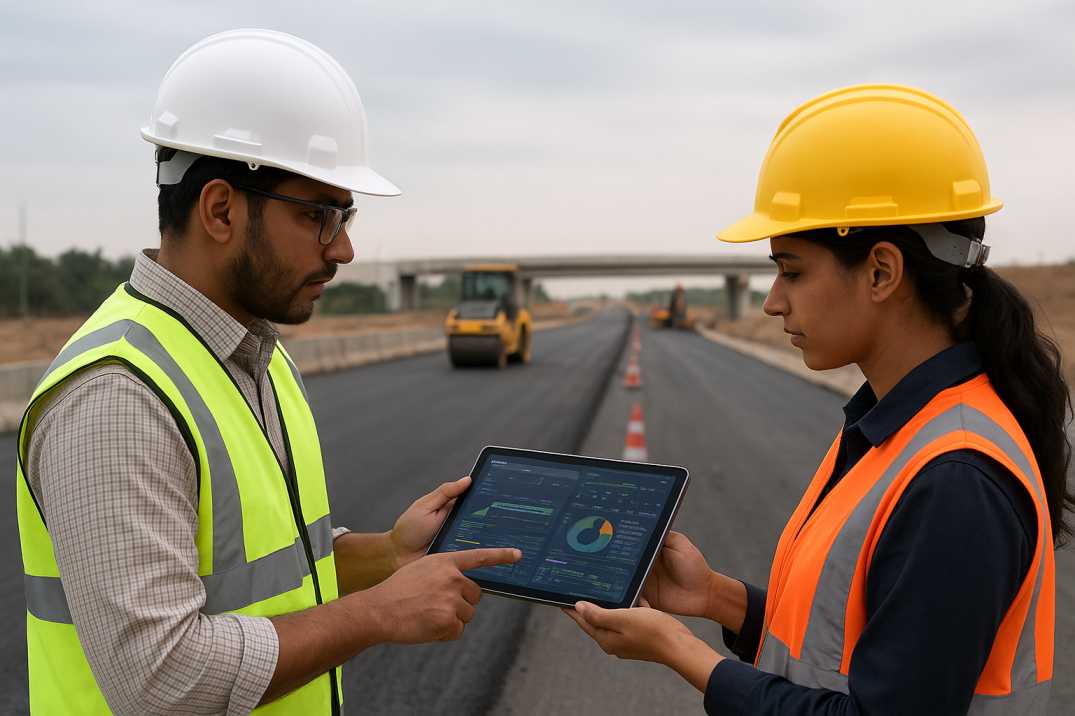Contact Us
RoadVision AI
Private Limited
Office No. 308 & 310, B Block
Ansal Chamber - 1, Bhikaji Cama Place,
Near Engineers India Limited (EIL) Bhawan, New Delhi - 110066
© 2024 | RoadVision AI | All rights reserved
Highway development in India is one of the largest infrastructure programs in the world, with more than 1,46,000 km of national highways forming the backbone of transport and trade. Ensuring the quality of construction on such a vast scale is a complex challenge. Traditionally, engineers relied on periodic inspections, manual testing, and paperwork to verify compliance with the Indian Roads Congress (IRC) specifications and Ministry of Road Transport and Highways (MoRTH) quality standards. While these methods have delivered results, they often lack speed, transparency, and real-time insights.
This is where AI-driven construction monitoring systems are transforming the process. By combining advanced imaging, data analytics, and connected devices, highway construction AI technology is enabling project owners, contractors, and governments to deliver smart roads in India with assured quality, improved safety, and optimized costs.

The MoRTH Quality Assurance Manual and IRC codes require contractors to implement systematic testing of aggregates, bitumen, soil compaction, and pavement layers during highway construction. Independent engineers also carry out random inspections to validate results. While this framework ensures compliance, it is heavily dependent on human reporting, which may sometimes lead to inconsistencies or delays in corrective action.
With AI quality monitoring construction systems, compliance with MoRTH and IRC guidelines becomes easier to track. Cameras, IoT sensors, and cloud-based dashboards continuously record material usage, layer thickness, temperature control, and compaction quality. This creates an evidence-based audit trail that supports road authorities in verifying quality in real time.
Traditional quality checks are performed in laboratories or field test sites at fixed intervals. This often leaves a gap between actual execution and reporting. For example, by the time test results highlight poor compaction or material segregation, large sections of pavement may already be laid, making rework costly.
AI-enabled construction monitoring systems bridge this gap. They capture images and process them instantly to detect cracks, improper jointing, or uneven surface profiles. Dashcam-based inspections, as deployed by RoadVision AI, allow continuous visual monitoring of road stretches, ensuring that defects are flagged before they expand into major failures.
Quality monitoring does not stop once construction is completed. Roads are long-term assets that require constant upkeep. Road asset management in India is being upgraded with AI-powered platforms that assess pavement condition, detect potholes, and forecast deterioration trends.
Solutions like pavement condition survey, road safety audit, road inventory inspection, and traffic survey provide critical data for highway authorities to prioritize repairs, budget resources, and enhance road safety. These systems align with international best practices while ensuring compliance with Indian standards.
The Government of India has set ambitious targets for highway development, with expressways, economic corridors, and smart city infrastructure expanding rapidly. To meet these goals, AI quality monitoring construction systems will become standard practice. By integrating AI, IoT, and drones, future construction projects will move beyond compliance toward predictive quality assurance, ensuring that Indian highways are not only longer but also safer, smarter, and more durable.
From initial blueprints to the delivery of smart roads, construction monitoring systems powered by AI are redefining quality control in highway projects. For contractors, this means higher efficiency and compliance; for governments, it ensures accountability and safety; and for citizens, it translates into reliable and resilient road infrastructure.
RoadVision AI is revolutionizing road infrastructure development and maintenance by leveraging cutting-edge AI in road safety and computer vision technology. Through advanced digital twin technology, the platform performs comprehensive road safety audits, enabling early detection of potholes, cracks, and other surface issues, ensuring timely repairs and improved road conditions. It also enhances traffic surveys by providing data-driven insights to address challenges like traffic congestion and optimize road usage. With a focus on building smart roads, RoadVision AI ensures full compliance with IRC Codes, empowering engineers and stakeholders to reduce costs, minimize risks, and improve the overall road safety and transportation experience.
To learn how AI-driven monitoring can enhance your road projects, book a demo with us today.
Q1. What is construction monitoring in highways?
Construction monitoring refers to the process of tracking quality, progress, and compliance of highway projects through inspections, testing, and now AI-enabled systems.
Q2. How does AI help in road asset management in India?
AI helps by detecting defects, predicting deterioration, and supporting data-driven maintenance planning to optimize road lifecycle costs.
Q3. Are AI construction monitoring systems recognized by Indian authorities?
Yes, they align with MoRTH and IRC guidelines, offering transparent and verifiable data for quality assurance.